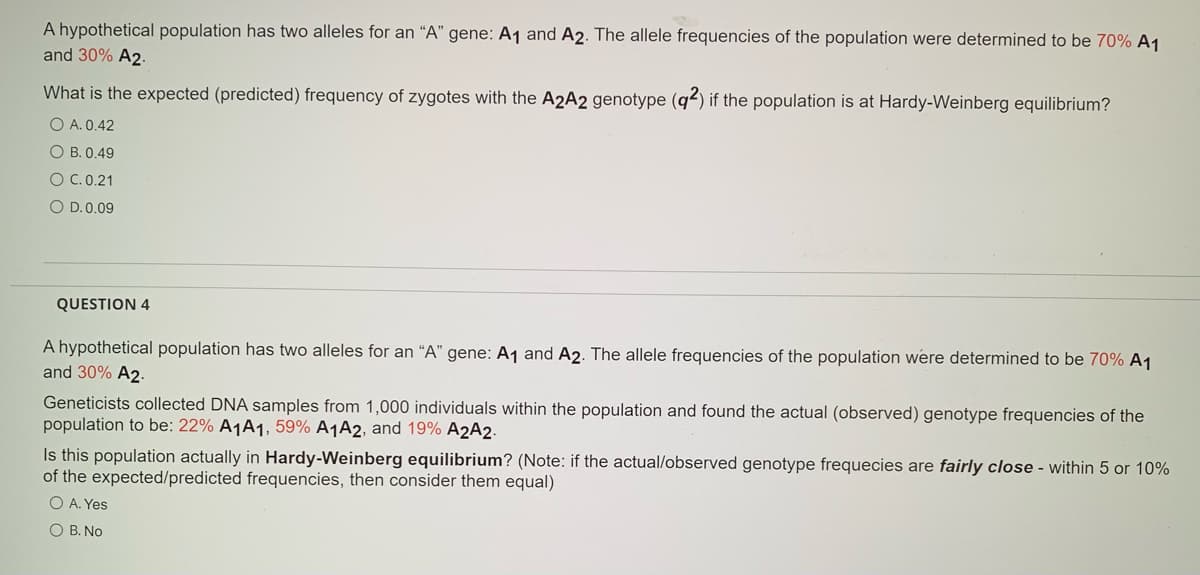A hypothetical population has two alleles for an "A" gene: A1 and A2. The allele frequencies of the population were determined to be 70% A1 and 30% A2. What is the expected (predicted) frequency of zygotes with the A2A2 genotype (q2) if the population is at Hardy-Weinberg equilibrium? O A. 0.42 O B. 0.49 O C.0.21 O D.0.09
A hypothetical population has two alleles for an "A" gene: A1 and A2. The allele frequencies of the population were determined to be 70% A1 and 30% A2. What is the expected (predicted) frequency of zygotes with the A2A2 genotype (q2) if the population is at Hardy-Weinberg equilibrium? O A. 0.42 O B. 0.49 O C.0.21 O D.0.09
Biology (MindTap Course List)
11th Edition
ISBN:9781337392938
Author:Eldra Solomon, Charles Martin, Diana W. Martin, Linda R. Berg
Publisher:Eldra Solomon, Charles Martin, Diana W. Martin, Linda R. Berg
Chapter19: Evolutionary Change In Populations
Section: Chapter Questions
Problem 4TYU: If a populations allele and genotype frequencies remain constant from generation to generation, (a)...
Related questions
Question

Transcribed Image Text:A hypothetical population has two alleles for an “A" gene: A1 and A2. The allele frequencies of the population were determined to be 70% A1
and 30% A2.
What is the expected (predicted) frequency of zygotes with the A2A2 genotype (q2) if the population is at Hardy-Weinberg equilibrium?
O A. 0.42
O B. 0.49
O C.0.21
O D.0.09
QUESTION 4
A hypothetical population has two alleles for an "A" gene: A1 and A2. The allele frequencies of the population were determined to be 70% A1
and 30% A2.
Geneticists collected DNA samples from 1,000 individuals within the population and found the actual (observed) genotype frequencies of the
population to be: 22% A1A1, 59% A¬A2, and 19% A2A2.
Is this population actually in Hardy-Weinberg equilibrium? (Note: if the actual/observed genotype frequecies are fairly close - within 5 or 10%
of the expected/predicted frequencies, then consider them equal)
O A. Yes
O B. No
Expert Solution
This question has been solved!
Explore an expertly crafted, step-by-step solution for a thorough understanding of key concepts.
This is a popular solution!
Trending now
This is a popular solution!
Step by step
Solved in 2 steps

Recommended textbooks for you

Biology (MindTap Course List)
Biology
ISBN:
9781337392938
Author:
Eldra Solomon, Charles Martin, Diana W. Martin, Linda R. Berg
Publisher:
Cengage Learning

Concepts of Biology
Biology
ISBN:
9781938168116
Author:
Samantha Fowler, Rebecca Roush, James Wise
Publisher:
OpenStax College

Biology (MindTap Course List)
Biology
ISBN:
9781337392938
Author:
Eldra Solomon, Charles Martin, Diana W. Martin, Linda R. Berg
Publisher:
Cengage Learning

Concepts of Biology
Biology
ISBN:
9781938168116
Author:
Samantha Fowler, Rebecca Roush, James Wise
Publisher:
OpenStax College